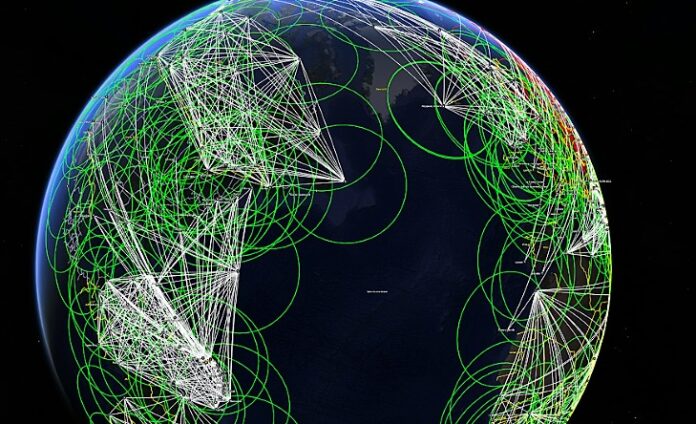
Point-to-point travel here on Earth may soon involve riding reusable, autonomous rockets. The idea has been around for a few years largely fuelled by SpaceX demonstrating its ability to recover the first stage of its Falcon 9 rockets after launch. Some are now at double-digit use with turnarounds between flights of less than two months.
But the goal of a successful rocket suborbital service would be similar to what is achieved today by commercial jets, that is, launch, land, refuel, reload and go, and do it in an hour. That is currently the U.S. Transportation Command’s (TRANSCOM) dream for cargo suborbital flights to deliver supplies anywhere on the planet in an hour. SpaceX, xArc, (Exploration Architecture Corporation), and TRANSCOM have budgets in place for a military program called Rocket Cargo. The goal is to develop the infrastructure and capacity to provide rocket cargo services to anywhere on the planet
What would it entail? A network of spaceports for launches and landings that would be the equivalent of the freight terminals found at commercial airports today. But instead of long runways, each spaceport would need a much smaller footprint. The biggest space requirement will be for fuel storage, a maintenance hangar, and the launch and recovery pad. The control tower wouldn’t need human operators. After fueling and cargo loading, the rockets would operate autonomously.
Back in 2018, at a TED Talk held in Vancouver, British Columbia, Gwynne Shotwell, President and COO of SpaceX, talked about the company’s vision for a rocket transportation network capable of delivering cargo and passengers or both anywhere on the planet within an hour. It seemed a bit fanciful at the time since the Starship, then referred to irreverently as the BFR, a rocket designed to bring this dream to reality, was a work in progress and early iterations looked more like flying silos than a futuristic means of suborbital-space transportation. Now four years later, SpaceX plans a test flight from its facility in South Texas with plans to fly to Hawaii in the first test of what may become the 21st century’s contribution to the evolution of mechanized transportation.
In sending rockets into space, to overcome the gravity well of Earth, the fuel and oxidizer represent almost the entire bulk and weight of the system. Payload is only a small component. But suborbital flight doesn’t need as much fuel and oxidizer allowing for bigger payloads. A thousand kilometre (620 miles) suborbital flight can deliver a hundred tons or more of cargo in 10 minutes. Compare that to a commercial jet which would take well over an hour, not including runway time at takeoff and landing. How cool would it be to step into a rocket, strap yourself in, and fly from New York to Shanghai in 40 minutes? That’s the future being envisioned.
Dr. Greg Spanjers is Chief Scientist of the Air Force Strategic Development Planning and Experimentation (SDPE) Directorate and heads up the Rocket Cargo program for the U.S. Department of Defence. He told AviationWeek recently that he “envisions fixed point-to-point transport to established sites.” The goal he stated is “the ability to deliver the cargo anywhere on Earth to support humanitarian aid and disaster relief.” But where disasters occur there may not be a suitable spaceport upon which to land and launch. Spanjers notes, therefore, that Rocket Cargo is looking beyond spaceports at “a wider range of novel trajectories to mitigate overflight issues, exploring a broad range of landing options for austere sites, researching human factors when landing near populations, and integrating a broader range of cargo including medical supplies.”
In a June 2021 article in Air Force Magazine, Spanjers stated that the timing for Rocket Cargo seems propitious. Why? He noted that “it looks like the technology may have caught up with a good idea” referring to SpaceX’s demonstrable ability to launch and land Falcon 9 rockets with high reliability, and the development of Starship with similar capability and large payload capacity. As a result, in January 2022, SpaceX was awarded a five-year $102 million contract to demonstrate the technology to transport cargo around the world using its rocket systems. Rocket Cargo sees SpaceX as the leading contender for the moment to demonstrate launch, landing, and relaunch capabilities with a short turnaround. But other commercial rocket companies are vying for the business including Jeff Bezos’ Blue Origin.
What is TRANSCOM’s role? It involves looking at ways to adapt current intermodal containers to make them compatible with rocket payload specifications. Ideally, the existing intermodal containers you see on trucks and container ships can be adapted to handle the G-force stresses associated with rocket flights.
But there is more to the story than just a rocket transportation system aimed at military provisioning. Toronto-based Digital Habitats President and CEO, Chris Smedley, has been developing plans for starports and a transportation network to connect the world for cargo and passengers. He calls this the Earth Starport Network.
What is this new network? Smedley describes it as a network “to deliver space transportation as part of our Planetary Mobility Services solution.” The network will allow for the delivery of cargo and people halfway around the world in under an hour with suborbital starflights. “The Earth Starport Network will disrupt all current forms of transportation by feeding our need for speed and addressing the scarcity of time,” says Smedley. The target date for the first cargo flights is 2025 with passengers to follow by 2028.








